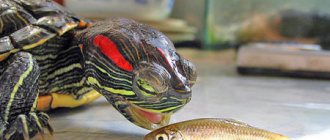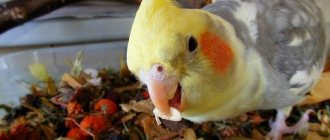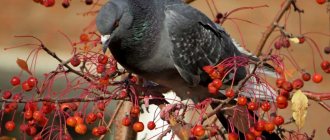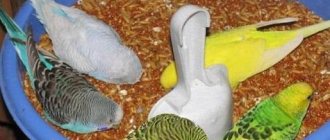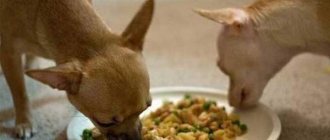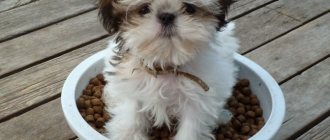It is necessary to feed a land turtle at home correctly; the diet must be complete and balanced. After all, high-quality food is the key to a long and healthy existence for a pet.
- 1 Food in natural habitat
- 2 Feeding characteristics of species 2.1 Omnivores
- 2.2 Herbivores
Keeping a land turtle at home
A turtle at home requires placement in an aquarium, terrarium or enclosure. There are many reasons for this. Crawling freely around the apartment, your pet may encounter such dangers as:
- dust that exists in every apartment - it can settle and accumulate on a turtle’s shell;
- bacteria that can cause various diseases;
- drafts;
- unsuitable temperature and humidity of the room where the animal crawls;
- lack of ultraviolet radiation, due to which the turtle may lack some vitamins that the body produces when exposed to sunlight;
- other domestic animals, for example, cats or dogs, and even the person himself can injure the land creature.
Caring for a land turtle besides nutrition
Any land turtle needs proper care, which includes maintaining the cleanliness of its home, itself, and ensuring a proper lifestyle. So, how to care for a land turtle:
- feed regularly and variedly in accordance with one or another habitual diet;
- bathe in warm water every week - this gives land turtles great pleasure, in addition, it helps to increase appetite and good intestinal function;
- take care of the claws - in captivity they do not have time to grind down as they grow, so they need to be trimmed periodically with a special nail clipper;
- take it out for walks in the fresh air - on warm and sunny days it is very useful to give the turtle the opportunity to walk in the open air, but you need to constantly monitor it, since it can disappear from sight in the depths of the grasses in a very short time.
What to feed a land turtle?
A natural question for novice tortoise lovers is: what to feed a land tortoise at home? Turtles are among the most unpretentious creatures. They eat little and do not require special care - they are not difficult to keep at home. All land turtles are herbivorous reptiles.
As mentioned above, their diet consists of 95% plant foods and 5% animal foods. The main diet of turtles is plant foods - berries, fruits, vegetables and grass. It is best to feed them a mixture of different ingredients - this way their diet will be varied and more balanced.
- greens, it makes up 80% of the entire menu (semi-dry or fresh salads, edible leaves, flowers, succulents, herbs.
- vegetables - 15% of the diet (pumpkin, cucumbers, zucchini, carrots...)
- fruits that are not very sweet (apples, pears, etc.) are represented in the menu 5%
Feeding food that is inappropriate for this group, such as meat, is fraught with diseases. You can put food on a flat saucer, the main thing is that it is convenient for the turtle to eat from it. The vegetable and fruit menu in the summer can and should be diversified with clover , dandelions, sorrel, sprouted oats, and pea leaves.
Additional food
once a week, it includes:
- non-poisonous mushrooms, such as russula, boletus, champignons, etc.
- dry balanced food for land turtles of the brands “Sera”, “Tetra”, “Zumed”.
- other: soybean meal, dry yeast, raw young sunflower seeds, bran, dried seaweed...
What does the turtle like?
Turtles' favorite foods are lettuce and dandelion leaves - they can even be dried for the winter. She is also partial to vegetables and fruits. The turtle can be fed field grasses and houseplants , such as: aloe, pea stems and leaves, tradescantia, alfalfa, timothy, lawn grass, plantain, gooseberry, rhubarb, sprouted oats, barley, thistle, sorrel, coltsfoot.
The vegetable menu consists of peppers, beans, pumpkin, carrots, zucchini, radishes, beets, artichokes, this list will be supplemented by cucumber and horseradish, which should not be given in large quantities.
It is allowed to feed land turtles with a variety of fruits and berries: apples, apricots, plums, peaches, mangoes, bananas, oranges, tangerines, watermelon, raspberries, strawberries, blueberries, wild strawberries, blackberries, blueberries. Additional complementary foods include: mushrooms, dry commercial feed, dry sea cabbage, young sunflower seeds, soybean meal, bran.
What should you not give to land turtles?
It is undesirable to feed onions, garlic, spinach, spicy herbs, grasshoppers, crickets, domestic cockroaches, poisonous insects, cherries, eggshells (causes salmonellosis), or feed one type of vegetable or fruit.
Prohibited foods include:
- potato,
- medicinal products containing alkaloids,
- indoor (dieffenbachia, euphorbia, azalea, elodea, ambulia, oleander, elodea.
- vitamin D2 and the drug gamavit (they are toxic to reptiles).
- milk, bread, citrus peels, seeds from fruits and berries, pet food, “human” food, including cereals (with the exception of rolled oats, which are not boiled, but soaked in water or vegetable juice, it should be given no more than once a day). month), meat, any prepared foods.
Poor nutrition causes irreversible changes in the animal’s liver, which can cause its life to be much shorter.
Feeding features of the species
All natural species of turtles are divided according to their feeding method into three large orders:
- predatory;
- herbivores;
- omnivores.
Each of them has their own list of food products necessary for a full-fledged existence. But among the land species of turtles there are no predators, so it is important to consider only the diet of herbivores and omnivores. When purchasing these pets, it is imperative to find out what type of food they belong to.
The omnivorous species that are suitable for keeping at home and most often found in the world are the Mediterranean, musk, flat and Balkan.
Mediterranean
musky
Balkan
Flat
Herbivores include star, Indian, Central Asian, Egyptian, serrated, red-headed, radiated, Galapagos.
Indian
Star-shaped
Galapagos
Radiant
Redhead
Serrated
Egyptian
Central Asian
Omnivores
Their diet must necessarily consist of live food, for example:
- mice and small rats;
- frog;
- snails;
- insects - tubifex, bloodworms, daphnia, beetles, caterpillars, worms;
- slugs;
- fish and seafood.
The plant part of the diet should contain:
- vegetables;
- fruits;
- berries;
- aquatic plants;
- various herbs.
Herbivores
80% of the diet of these land turtles should be products of plant origin - various salads and spinach (leafy part), dandelion, cabbage.
Additional food:
- vegetable crops - pieces of carrots, cucumbers, zucchini, tomatoes, sweet peppers;
- fruits - apples, pears, peaches, apricots, bananas, citrus fruits;
- berries - cherries, raspberries, strawberries, grapes, currants, watermelon;
- other herbs - coltsfoot, sorrel, plantain, alfalfa, legumes;
- mushroom crops, such as champignons;
- special prepared food;
- bran and flakes from plant crops, sunflower seeds.
We recommend reading the article on what to feed pet turtles.
List of prohibited foods for feeding turtles
If you feed your turtle incorrectly, irreversible pathological processes in the liver may occur. The introduction of prohibited foods to the menu can cause the death of your pet.
Their list is very extensive. It is prohibited to give to reptiles:
- spicy herbs;
- herbs rich in alkaloids;
- onion and garlic;
- potato;
- zest;
- milk;
- cat and dog food;
- eggshells, as they can be contaminated with bacteria of the genus Salmonella;
- poisonous indoor plants (water plague, oleander, limnophila, azalea, spurge, dieffenbachia);
- domestic cockroaches, crickets and grasshoppers;
- vitamin D2, since it is poisonous;
- dishes from the owners' table: sausages, sausages, cheese, porridge (you can give rolled oats, which need to be steamed and not boiled), canned food, fried and boiled food.
Vitamins for the health of land turtles
Vitamin and mineral supplements are desirable in the diet of land turtles kept at home. Carbonate, bone meal, ground eggshells, and glycerophosphate can be used as mineral additives. They should be given at the rate of 100 mg per 1 kg of animal weight. As for vitamins, the Central Asian domestic land turtle needs natural sources of vitamins A, B12 and D3. You should not give her oil preparations and vitamin D2. She must get everything she needs from food.
What to pay attention to when feeding a turtle?
It is very important to understand that a turtle is a living creature that requires care and attention, and not a toy that can be played with and left to the mercy of fate. If you have chosen these unique reptiles, take a responsible approach to the question of what to feed your turtle at home.
After all, the health and life of your pet depends on it. The more seriously you take the conditions of its existence, the longer the turtle will be able to please you. When buying a turtle, contact experienced sellers who can tell you what to feed a water turtle at home and what to feed a land turtle, so that later you don’t have to guess why your pet died, because you fed it.
It turns out that if a turtle is not fed correctly, it begins to be capricious, eat poorly, or even refuse food altogether. or steppe turtles are no exception. In order for your pet to feel at ease, properly structure your baby’s diet.
Errors
- Feed your reptile too often. This will cause overeating and indigestion.
- The reptile body is adapted to consume a certain type of food. You cannot feed a herbivore only meat, and a carnivore only fruits and vegetables.
- Giving your pet food too rarely. The individual will be weak, lethargic, inactive and susceptible to disease.
If you follow the rules of feeding land reptiles, they will have good health and longevity.
Sources:
https://womanadvice.ru/chem-kormit-suhoputnuyu-cherepahu-zimoy https://myturtle.ru/chem-kormit-krasnouxuyu-cherepaxu/ https://rybkies.ru/obitateli/chem-kormit-suhoputnuyu-cherepahu -v-domashnih-usloviyah.html
What to feed a land turtle in winter?
Turtles usually hibernate during the winter. But the house is quite warm during this cold period. Therefore, the turtle does not sleep, but simply becomes slow. What should you feed your land turtle at home during this period?
Food products can be left the same. But don't be surprised if your little friend can't make it through the summer daily quota. An approximate daily diet can be calculated for the winter period, and it will look something like this:
- carrots – 30 grams,
- boiled potatoes - 20 grams,
- cabbage – 30 grams,
- white bread – 20 grams,
- fish oil - 0.5 grams,
- beets – 20 grams.
Just don’t forget to enrich this list with herbs in the summer, for example, dandelion, the leaves of which can be picked far from a busy and polluted highway and city.
Sample menu and additional components
The menu for your pet should be prepared in advance so that you don’t have to worry about the lack of certain foods in the diet.
Sample menu:
- 50 g of green stems are given every two to three days.
- Beet pieces should be given. No more than 30 g per day.
- 30 g of cabbage leaves once every 1–2 days.
- Boiled potatoes in the amount of 30 g per day.
- Proteins enter the turtle's body through the consumption of bloodworms, worms, and lean meat pieces. There should be no more than 5 g per day.
- White bread – 20 g per day.
- Vitamin supplements, such as fish oil. There should be no more than 1 g per day.
- Porridge – semolina, buckwheat, cottage cheese. Do not give more than once a week.
Does a land turtle need to be given water?
We told you what to feed domestic land turtles. But, after all, they also need water, although they drink quite rarely: some drink it once every one to two weeks, while for others one “date” with water a month is enough. The frequency with which water treatments need to be administered depends on what the animal eats over a certain period of time. If it is cabbage, then the cells of the turtle’s body receive a sufficient amount of moisture, and you will have to “bathe” less often. But if the majority of the daily diet consists of white bread, baths should be arranged a little more often.
Although, in order not to rack your brains, give your turtle a bath day once a week or a week and a half. Pour a little less than a centimeter of water into the basin. The pet's nose must be above the water level so that the land inhabitant of our planet does not suffocate. Place the animal in the water and leave it to enjoy for half an hour. Believe me, this time is enough for the baby to have time to get drunk and take a swim.
Unfortunately, many people do not take turtles seriously enough, not like other pets, they know little about the peculiarities of keeping and caring for them, and most importantly, they have little interest in the question of what to feed turtles. But these babies also require a balanced diet, various nutritional supplements for active growth and well-being.
Omnivores
Despite the name, semi-aquatic and marsh turtles are the most demanding in terms of food composition. In addition, their diet can change significantly during the period of growing up.
The optimal composition of the diet depends solely on the type of turtle. In addition, it is necessary to determine how many times to feed small turtles, whose main diet consists of food of animal origin.
Three groups of turtles
Based on their feeding type, turtles are divided into three groups: carnivores, omnivores and herbivores.
. Each of them corresponds to a certain ratio of animal and plant foods. Feeding inappropriate food for each group of turtles is fraught with diseases of the internal organs, digestive complications, and metabolic problems. You also need to include calcium and vitamins in your diet weekly. What food should be given to each group?
Predatory
The food of predatory turtles should consist of 80% animal food and 20% plant food. This group includes almost all aquatic species and all young aquatic ones, such as young red-eared, caiman, trionics, swamp, musky, etc.
The main food for them is:
- lean fish, live or thawed, with entrails and small bones. For young turtles, the fish should be finely chopped (spine, excluding ribs) with bones, for adults - whole or large pieces. Large bones can be ground or finely chopped.
- beef or chicken liver is given once a week;
- seafood such as green (not pink) shrimp, sea cocktail;
- mammals (small): naked mice, rat pups, runners.
The turtle can eat all seafood, as well as fish, only raw; heat-treated food should not be given;
Additional food
, which should be given once a week, serves:
- Dry food for freshwater turtles, for example, in the form of sticks, tablets, flakes, granules, capsules, Sulfur, etc.
- Insects: moth, food cockroaches, grasshoppers, bloodworms, crickets, earthworms, gammarus and so on;
- Mollusks, amphibians, invertebrates: slugs, frogs, small snails with shells, tadpoles and similar swamps.
It is prohibited to give to predatory turtles:
meat (beef, chicken, pork, lamb, sausages, sausage, any type of minced meat, etc.), as well as fatty fish, milk, cheese, bread, fruit, dog or cat food, etc.
The diet of this group of turtles should consist of 50 percent animal food
and 50 - vegetable. Omnivorous turtles include semi-aquatic and adult aquatic turtles, some types of land turtles: spiny turtles, coora turtles, adult red-eared turtles, Spengler's turtles, red-footed turtles (coal turtles), etc.
Their menu consists of half animal food, see the list above, and half plant food, the list is below. Aquatic turtles are pampered with fish
and seafood (as animal food), and mice are given to land animals.
- Plant food for aquatic species are plants growing in water conditions;
- Land animals are given plants that live on the ground, and fruits and vegetables are added to them.
How and what to feed a turtle: general features
Rational and balanced nutrition
Like the diet of other pets, the diet of any type of turtle should be rational and balanced. A harmonious menu of different types of foods, including both plant and animal foods, is necessary for turtles of all types.
It is also important to ensure that these animals always have access to a shallow bowl of water, which needs to be changed daily.
Regularity of nutrition
It is important to maintain regular nutrition. An adult turtle of medium size should eat at least half a head of lettuce or at least a smaller amount of other food every day.
If your turtle eats almost nothing, you should definitely pay attention to this: it is likely that your pet is sick. It is advisable to get a scale and periodically weigh the animal, noting fluctuations in its weight, in order to promptly notice the occurrence of problems with your pet’s health.
The importance of calcium in food
It is especially important for turtles to have calcium in their food, which ensures their shell and bone strength. Since there is almost no this important element in plants, it is worth purchasing vitamin supplements containing calcium and adding them to the turtle’s food.
It is important to follow the dosage of such supplements, since excessive use will have adverse effects on the animal.
Feeding turtles at home
When wondering what to feed a turtle at home, you should first of all focus on the type of animal, depending on which the choice of rational nutrition is made.
Choosing food that is inappropriate for a particular type of turtle can lead to metabolic disorders in the animal and problems with digestion.
How to organize feeding a turtle
You can feed your turtle in different ways:
- placing food in the water of the aquarium;
- from tweezers;
- leaving food on the sushi island in the aquarium;
- outside the aquarium if you do not want to pollute the water with food debris.
It’s worth hand-feeding the turtle at first so that the animal gradually gets used to being independent and comes to you to eat on its own. It is worth accustoming to new foods gradually, and if there are several turtles, it is worth making sure that all animals get food. Turtles do not eat cold food, so food must be taken out of the refrigerator in advance and given to the animal to eat only when it reaches room temperature. It is advisable to feed the turtle during the day, when the animal is most active, or, alternatively, a couple of hours before bedtime.
Adult red-eared turtles should be fed once every few days, young ones - every day. A land turtle should be fed once every 2 days for an adult and once a day for young animals. Dry food should be consumed only as a supplement to the main food. Young individuals and females in anticipation of offspring must eat every day, and their menu must certainly include calcium and vitamin D in significant amounts in such cases.
Land turtles are the most popular species of reptile. Pets are unpretentious in keeping. Under natural conditions, turtles independently obtain their own food - food of animal and plant origin. But when buying a home, the owner of the animal takes on the responsibility of what to feed land turtles at home.
The diet of land turtles must be varied and contain all the substances and trace elements necessary for the reptile’s body.
The most popular types of land reptiles kept in people's homes among owners are:
- Central Asian (steppe).
- Mediterranean (Greek).
- Egyptian.
- Balkan.
- Musky.
- Leopard (panther).
- Elephant (Galapagos).
- Star (Indian).
- Serrated (yellow-legged).
- Red-headed flathead turtle.
- Radiant turtle.
Artificial feed
Pet stores provide pet owners with a huge selection of food for land and aquatic turtles. It is sold in capsules, granules, tablets and flakes. The large amount of food produced by manufacturers does not always meet the needs of a particular species. Often, turtle food is modified fish food. Some animals are irritated by the pungent smell, and they demonstratively turn away from it. There are foods in which the content of calcium, protein and vitamins does not meet the needs of turtles. But some animals are happy to eat only food. Of the manufacturing companies, JBL, Sera, Nutra Fin, Tetra have proven themselves well.
Homemade food for red-eared turtles
If store-bought artificial food is not suitable, you can prepare your own treats for turtles.
Feed composition:
- cabbage – 50 gr.;
- carrots – 70 gr.;
- non-fatty fish – 145 g;
- apples – 50 gr.;
- squid meat – 100 gr.
Cooking method. All ingredients should be passed through a meat grinder, add 2 eggs, gelatin diluted in hot water (per 150 ml - 30 g) and milk in a volume of 150 g. Mix thoroughly, let cool and add 20 drops of Tetravita. The shelf life of the food in the refrigerator is 1 week. Before feeding, the mixture is cut into pieces and given to the turtle.
Article on the topic: Vetom, a highly effective veterinary drug for animals and poultry
The prepared food is enough for 10 feedings, per 1 turtle with a shell length of 15 cm. If the animal is sick, you can add medicine to the food. Gelatin can be replaced with agar-agar. This will prevent the cubes from quickly melting in the water.
Feeding turtles food for cats and dogs. "Pros and cons"
Red Ears really like combined foods, but they are intended for feeding warm-blooded animals and are not suitable for turtles. The food contains a completely different set of substances that are useful for cats and dogs, but completely useless for turtles.
What to feed your turtle?
In the wild, the land turtle obtains its own food. These animals love to eat grass, various algae, roots, and berries. The owner's first task when keeping a reptile of this species should be to provide proper and balanced nutrition.
Note! The further condition and development of the pet will depend on a well-formulated diet.
It is important that the menu included various mineral components and vitamins that will ensure the growth of the pet.
A turtle at home should eat the following food:
- greens - clover leaves, wheat germ, leaves, dandelion flowers, coltsfoot, parsley stems and leaves, lettuce leaves, aloe;
- various vegetable crops. Amphibians are especially fond of carrot roots, cabbage leaves, green peas, beets, pumpkins, zucchini, tomatoes, and fresh cucumbers;
- Freshwater animals gobble up various types of berries for their sweet souls. To feed them you can use cherries, currants, raspberries, grapes, strawberries;
- Be sure to include a sufficient amount of fruit in your diet.
To make feeding comfortable, all hard fruits and vegetables can be cut into small pieces. Bananas and soft berries can be given whole. Before giving fruit from them, all seeds must be completely removed, otherwise the reptile may choke on them.
What else can you feed a land turtle at home? An amphibian's menu must contain protein foods. It is required to maintain vitality, active growth and development of the reptile. Protein foods include various mucus, worms, and boiled lean meat can also be given. But under no circumstances should you include various cockroaches and crickets in your pet’s diet. It is better to purchase red worms at a pet store.
What to feed a land turtle at home
Turtles are classified as omnivores. What does a land turtle kept at home eat? It is advisable to include not only plant foods in the diet. Twice a week you should give a turtle kept at home snails, crickets, and worms. Your pet will happily eat fresh fruits, vegetables and berries: melons, apples, tomatoes, carrots, broccoli. Always balance your turtle's diet. Some of them prefer sweet fruits, which should be alternated with other foods to ensure that their diet is full of nutrients and minerals. Leafy greens are an excellent addition to this animal's diet.
Among the favorite delicacies of turtles are:
- small fish;
- crayfish;
- crickets.
It is advisable to buy turtle food at a pet store to supplement the diet with some vitamins that they lack in captivity.
Feed your pet turtles a plant-based diet:
- clover and dandelions;
- parsley and lettuce;
- carrots and cabbage;
- raspberries and grapes;
- apricots and plums;
- bananas, apples, oranges.
By using these tasty foods in your pet's diet, you can provide her with an ideal environment in your home.
We should not forget that the turtle needs to be fed dry food (sea kale, seeds, champignons, bran, dry yeast, etc.)
Description
The low carapace (carapace) is almost oval; if you look at it from above, you can see that the width in the back is slightly wider than in the front. The length of the shell is 20 cm or more in adult large turtles. Since water has always been the key habitat for turtles, the carapace scutes naturally fit perfectly together. In terms of their structure, the carapace and plastron are completely streamlined and have no protrusions. Large claws are located on the legs, small membranes are located between the toes. The claws of a swamp turtle can easily tear prey apart and can significantly scratch your hand.
The tail of this turtle is relatively long, can reach 3/4 of the length of the carapace (about 12 cm) and during swimming it takes part as an auxiliary rudder during any turns (the main steering is carried out by the legs) and as a counterweight that holds the turtle in the required position during maneuvers. The carapace usually has a dark olive, dark green, sometimes almost black color, the plastron is light, yellowish. The shell, neck, head, legs are covered with small light spots. Often females have yellow eyes, while males are slightly reddish. Females have slightly shorter tails than males.
Animal Species
Based on the way reptiles climb into their shells when in danger, two suborders are distinguished:
- Side-necked. The head is hidden in the direction of one of the paws.
- Hiddencervical. The neck is folded in an S-shape.
Experts identify several varieties of turtles living on land:
- Elephant (Galapagos). The weight of the animal sometimes reaches 390 kg, length 1.8 meters. The size of reptiles depends on the climatic conditions of their habitat. In arid areas, the shell is saddle-shaped and the limbs are long. In areas with high humidity, the carapace is dome-shaped.
- Egyptian. The smallest turtle. The size of males is no more than 12 cm. Females are larger. The shell has a brownish tint. Habitat: Middle East.
- Land Central Asian tortoise. Body about 19 cm. Carapace yellow with spots, round. The forelimbs have four toes. This is the most popular type for home maintenance. The land turtle lives up to 49 years. Habitat: India, Syria, Tajikistan, Uzbekistan, Kyrgyzstan. Due to capture for sale, the population has practically disappeared.
- Panther. The length of the animal's shell is more than 0.8 m, weight is about 49 kg. The carapace is dome-shaped and tall. Its color is yellow-sandy. Young turtles have a clearly visible dark brown spotted pattern. As the animal grows, it disappears. Habitat: Africa.
- Speckled Cape. The smallest turtle on Earth. The size of the shell is no more than 9 cm, weight from 96 to 164 grams. Lives in Namibia and South Africa.
Turtles live everywhere. The exceptions are: Greenland, Antarctica, Arctic, New Zealand.
Reproduction
In the spring comes marriage time. During this period, turtles (age 6–8 years and shell 9–12 cm) are far from water bodies. Turtles can also mate in water. The sperm of turtles can be stored in the female’s tract for up to 1 year or more; as a result, a female caught in the wild can “personally” lay completely full-fledged eggs after 5-6 months. Between May and July, females lay eggs three times in holes dug in the ground. During the season, the female produces 1–3 clutches. The depth of the pits is approximately 10 cm. The eggs that fall into them are beautiful: their shells are snow-white, they themselves have an oblong, regular shape, size 30 x 20 millimeters, weight approximately 8 g. In any clutch there are about 5–10 eggs, and they The female buries it most carefully. After approximately 2-3 months, these eggs produce tiny turtles about 24–25 millimeters long, weighing 5 g, with a large yolk sac on the belly.
The shell of young turtles is usually dark brown with yellow lines. They dig small tunnels near the nest, where they spend the winter in most cases. In the spring, turtles crawl out of their shelters onto the surface of the earth and begin an independent life. The incubation temperature is about 25–30°C and the duration is 54–90 days. Incubation humidity 90%. The water depth for newly born turtles is approximately 5 cm. Young individuals feed on daphnia and insect larvae.
Mating season
Reproduction in reptiles occurs at different times. It depends on the location and type of animal. But all members of the class have similar traits. For the right to fertilize a female, males enter into battle with each other. Land turtles try to turn over or force their opponent to retreat by striking them with their shells. After the competitor leaves the battlefield, the winning male begins courtship. At the same time, he tries to ensure that the female takes the best position for mating.
To attract a mate, the male strokes her face with his limbs or sings.
Females dig holes in the sand to lay eggs. They also often use crocodile nests or their own burrows. The masonry is securely covered with soil from above, and then compacted with light blows of the shell.
The surface of the eggs is covered with a leathery membrane or shell. There are up to 190 of them in the clutch. The incubation period is 91 days. The female lays several clutches during the mating season.
Turtles are solitary reptiles. They look for a mate only during the mating period.
Feeding the turtle
For the normal development of a turtle, a varied diet is needed, including fresh vegetables (lettuce, cucumbers, cabbage, tomatoes, carrots, pumpkin), greens (dandelion, plantain, coltsfoot). At the same time, we must not forget that the turtle loves most - fruits (watermelon, melon, apple) and berries (strawberries, raspberries, cherries).
She is not averse to dining on cooled semolina or buckwheat porridge, and will also not refuse oatmeal prepared in the traditional way.
To prevent her from getting sick from a lack of nutrients, cottage cheese, boiled eggs, and raw minced meat should be added to the main diet. At the same time, there is no need to give her something to drink, since she gets most of her liquid from vegetables and fruits, and besides, she can drink while taking a bath.
The diet of an aquatic turtle is mainly meat and fish, but it will not refuse snails, worms, mice, etc. But this does not mean that she should not be given food of plant origin. It should be at least 30% in the diet of an aquatic turtle.
Drink
These reptiles do not require daily water intake. Reptiles obtain the necessary fluid by consuming succulent food - greens, vegetables and fruits.
They have the ability to absorb the right amount of water through the pores of the skin. It will be enough to place a water tank in the terrarium 1-2 times every week for 15 minutes. The water level should not be too high, about halfway through the shell. The head is located above the surface of the water. The reptile will not suffer from thirst. The water balance in the body will be at a stable level.

